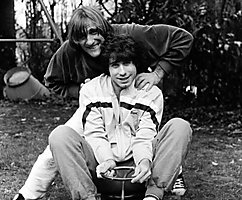The deformation of the head
 Bashny.Net
Bashny.Net
In a number of nations there is still a rather strange, in our view, the custom of head deformation.
With a variety of tricks that can be reduced to limit the opportunities for the development of the cranium, the representatives of these peoples achieve unnatural shape of the head.
Since the growth of the skull is much slower than the other bones of the skeleton, and with age the bones of the skull are less susceptible to external influence, to obtain the deformed shape "sculptor living head" have to "work with the material" for quite a long time and to begin in early childhood " blank. "
Below are pictures of a deformation of the head tribes of the Congo, Sudan and the islands of the New Hebrides (western Pacific).

As the archaeological finds, the practice was fairly widespread and deeply rooted in antiquity.
For example, the following practices strain can be traced in the Americas.
In North America, cranial deformation observed the Maya and various other tribes. And she practiced until very recently.
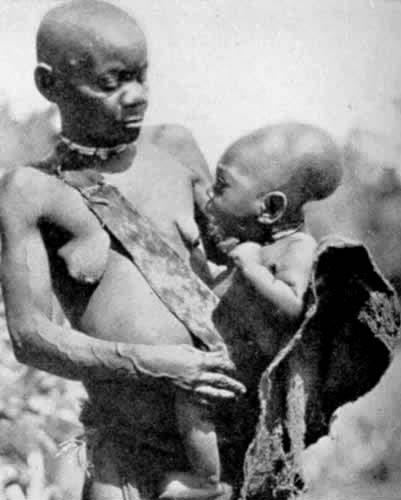
It is characteristic that in some places the practice of cranial deformation was of a very massive. For example, on an artificial island Hein, now separated from the Yucatan Peninsula, a narrow strip of water between 10 and 100 meters, in one of the tombs of the 24 preserved skulls of 13 adults were male - in eight cases there is deliberate cranial deformation. 11 were women, out of which only four cases, there is a deliberate distortion of the skull.
In general, the ratio of deformed and non-deformed skulls is 12:12. In most cases, the deformation is the traditional Mayan fronto-occipital character, but sometimes even goes on the nose.
This is a very prevalent practice wore deformation and in South America, which can be found in many cultures of the continent - Chavin, Laurikocha, Paracas, Nazca
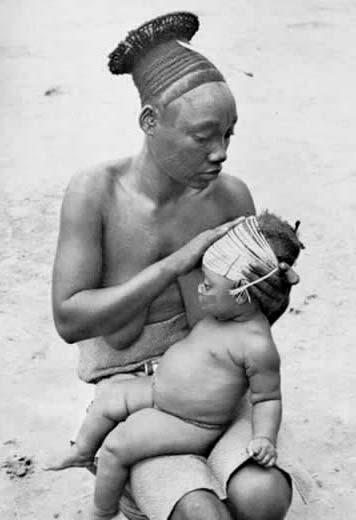
There is a version that even well-known Easter Island Moai depict figures with elongated heads, and their strange reddish "hats" - actually just hair, and beneath which hides the elongated shape of the head.

Thus, the practice of head deformation has (and had in the past) is very wide geography.
At the same time observed a definite pattern: For all the variety of methods and forms of influence on the shape of the skull (by tight bandages-caps to special structural wood fixtures) is clearly dominated by the desire to achieve a result of deformation - elongated head.
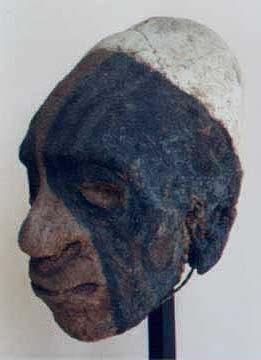
There is a legitimate question: what are the origins of such a massive (and uniform in all the regions!) Desire for an elongated head shape? ..
The question is - is not idle, given the data of modern medicine that a similar effect on the head in addition to the nuisance and discomfort contributes to regular headaches and increases the risk of serious adverse effects on the mental and physical health in general.

Official history does not however a comprehensive answer to this question, writing off all only on ceremonial with incomprehensible motivation. However, even with all the power of the real impact of religion and worship for the whole lifestyle of the people, it is not enough.
For such a "fanatical pursuit of ugliness," there must be a very powerful incentive. And incentives fairly stable, given the ubiquity and the duration of this "tradition".

In recent years, more and more researchers tend to neurophysiological version. Changing the shape of the skull has an impact on different areas of the cerebral cortex, which helps to change certain traits and skills of a person.
Serious research in this area has not even begun. But even without them, among still practice tribal skull deformation something not noticed any particular improvements in mental abilities.
And the clergy (priests and shamans), for whom the ability to, for example, fall into a trance, or enter into meditation is very important to the deformation of the skull does not seek.

These skulls were photographed by Robert Connolly on his travels around the world, during which he collected various materials about ancient civilizations.
The discovery of these skulls was a surprise for him. Robert Connolly published photographs of these skulls, and the results of their research on a separate CD-ROM, calling it a "search of ancient wisdom" in 1995.

The first thing that catches the eye - it is abnormal shapes and sizes, have nothing to do with the skull of modern man but the most common features ("box" for the brain, jaw, holes for eyes and nose) ...
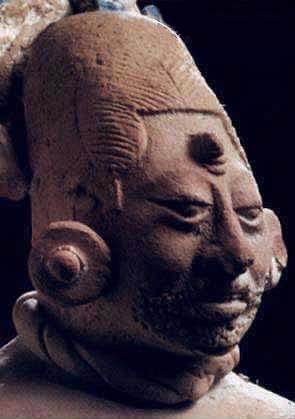
The fact is that during the intentional deformation of human skulls can change the shape of the skull, but not its scope.
Some photographs show the skull, exceeding the volume of a normal human skull almost twice!

(In fairness it should be noted that there are cases among men increased size of the cranium in certain diseases.
However, such a degree of deviation from normal head size dimensions are close to the people as "vegetable" and to adulthood do not survive.)

Unfortunately, although for those who admits the possibility of real existence of ancient "gods" in the flesh, the version voiced Denikenom, downright suggests, it is not too far away from a strange interpretation of the tradition as a cult ritual ...
Of course, imitation of real prototype much more consistent with the fact that uniformity of shape deformation on the vast territory, covering almost all the continents, rather than the desire to imitate invented the cult image, but can still move a little further? ..
Let us turn to another phenomenon also associated with exposure to the skull, namely a craniotomy since ancient times.

The fact of the successful operations of trepanation in ancient times (Daily Telegraph recently reported the discovery on the banks of the Thames with traces of trepanation of the skull, dating back to 1750-1610 BC.) Is already considered reliably established.
The fact is that, firstly, the character trepanation orifices at very different from wounds inflicted upon impact by a weapon, - no cracks in the skull around the hole. And secondly, it is possible to definitely establish the patient's survival after such an operation.
Surgeons and anthropologists know that if a successful trepanation, that is when the patient is unable to die, a hole in the skull gradually closes recovering bone. If the skull is no trace of healing, which means that the patient died during surgery or shortly thereafter.
In this case there are traces of inflammation of the bone at the edges of the hole.

Source:
With a variety of tricks that can be reduced to limit the opportunities for the development of the cranium, the representatives of these peoples achieve unnatural shape of the head.
Since the growth of the skull is much slower than the other bones of the skeleton, and with age the bones of the skull are less susceptible to external influence, to obtain the deformed shape "sculptor living head" have to "work with the material" for quite a long time and to begin in early childhood " blank. "
Below are pictures of a deformation of the head tribes of the Congo, Sudan and the islands of the New Hebrides (western Pacific).

As the archaeological finds, the practice was fairly widespread and deeply rooted in antiquity.
For example, the following practices strain can be traced in the Americas.
In North America, cranial deformation observed the Maya and various other tribes. And she practiced until very recently.

It is characteristic that in some places the practice of cranial deformation was of a very massive. For example, on an artificial island Hein, now separated from the Yucatan Peninsula, a narrow strip of water between 10 and 100 meters, in one of the tombs of the 24 preserved skulls of 13 adults were male - in eight cases there is deliberate cranial deformation. 11 were women, out of which only four cases, there is a deliberate distortion of the skull.
In general, the ratio of deformed and non-deformed skulls is 12:12. In most cases, the deformation is the traditional Mayan fronto-occipital character, but sometimes even goes on the nose.
This is a very prevalent practice wore deformation and in South America, which can be found in many cultures of the continent - Chavin, Laurikocha, Paracas, Nazca

There is a version that even well-known Easter Island Moai depict figures with elongated heads, and their strange reddish "hats" - actually just hair, and beneath which hides the elongated shape of the head.

Thus, the practice of head deformation has (and had in the past) is very wide geography.
At the same time observed a definite pattern: For all the variety of methods and forms of influence on the shape of the skull (by tight bandages-caps to special structural wood fixtures) is clearly dominated by the desire to achieve a result of deformation - elongated head.

There is a legitimate question: what are the origins of such a massive (and uniform in all the regions!) Desire for an elongated head shape? ..
The question is - is not idle, given the data of modern medicine that a similar effect on the head in addition to the nuisance and discomfort contributes to regular headaches and increases the risk of serious adverse effects on the mental and physical health in general.

Official history does not however a comprehensive answer to this question, writing off all only on ceremonial with incomprehensible motivation. However, even with all the power of the real impact of religion and worship for the whole lifestyle of the people, it is not enough.
For such a "fanatical pursuit of ugliness," there must be a very powerful incentive. And incentives fairly stable, given the ubiquity and the duration of this "tradition".

In recent years, more and more researchers tend to neurophysiological version. Changing the shape of the skull has an impact on different areas of the cerebral cortex, which helps to change certain traits and skills of a person.
Serious research in this area has not even begun. But even without them, among still practice tribal skull deformation something not noticed any particular improvements in mental abilities.
And the clergy (priests and shamans), for whom the ability to, for example, fall into a trance, or enter into meditation is very important to the deformation of the skull does not seek.

These skulls were photographed by Robert Connolly on his travels around the world, during which he collected various materials about ancient civilizations.
The discovery of these skulls was a surprise for him. Robert Connolly published photographs of these skulls, and the results of their research on a separate CD-ROM, calling it a "search of ancient wisdom" in 1995.

The first thing that catches the eye - it is abnormal shapes and sizes, have nothing to do with the skull of modern man but the most common features ("box" for the brain, jaw, holes for eyes and nose) ...

The fact is that during the intentional deformation of human skulls can change the shape of the skull, but not its scope.
Some photographs show the skull, exceeding the volume of a normal human skull almost twice!

(In fairness it should be noted that there are cases among men increased size of the cranium in certain diseases.
However, such a degree of deviation from normal head size dimensions are close to the people as "vegetable" and to adulthood do not survive.)

Unfortunately, although for those who admits the possibility of real existence of ancient "gods" in the flesh, the version voiced Denikenom, downright suggests, it is not too far away from a strange interpretation of the tradition as a cult ritual ...
Of course, imitation of real prototype much more consistent with the fact that uniformity of shape deformation on the vast territory, covering almost all the continents, rather than the desire to imitate invented the cult image, but can still move a little further? ..
Let us turn to another phenomenon also associated with exposure to the skull, namely a craniotomy since ancient times.

The fact of the successful operations of trepanation in ancient times (Daily Telegraph recently reported the discovery on the banks of the Thames with traces of trepanation of the skull, dating back to 1750-1610 BC.) Is already considered reliably established.
The fact is that, firstly, the character trepanation orifices at very different from wounds inflicted upon impact by a weapon, - no cracks in the skull around the hole. And secondly, it is possible to definitely establish the patient's survival after such an operation.
Surgeons and anthropologists know that if a successful trepanation, that is when the patient is unable to die, a hole in the skull gradually closes recovering bone. If the skull is no trace of healing, which means that the patient died during surgery or shortly thereafter.
In this case there are traces of inflammation of the bone at the edges of the hole.

Source:
Tags
See also
Disappeared of the country (10 photos)
Want to know everything...
Mexico. 5000 km
My trip to Peru.
Now I know where the end of the earth!
The pale horse of death
Google Glass: release date, specifications, price and partnership with Ray-Ban and Oakley
The history of special effects in cinema
Educational program on the map projection with pictures
Great civilizations









